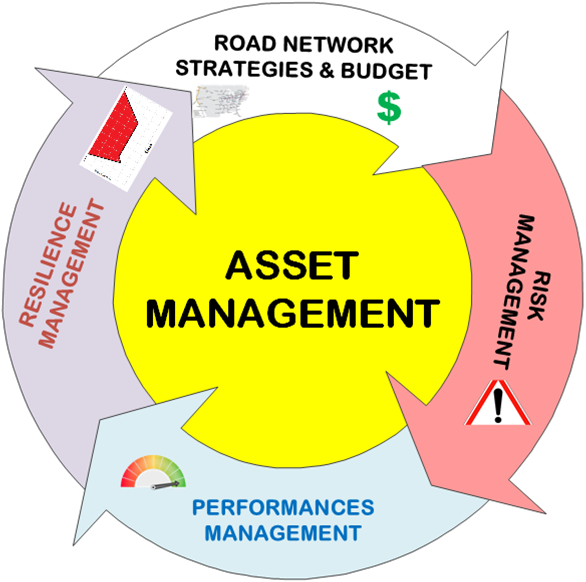
Asset Management Manual
A guide for practitioners!

Asset Management Manual
A guide for practitioners!
The word “Resilience” comes from the field of structural mechanics and it refers to the ability of a material to withstand damaging actions after recovering from a previous yielding state. In the past 50 years, the derivative of this concept, in terms of “ability to recovery from adversities or disturbances”, has been extended to a wider range of fields, such as psychology, ecology, sociology, urban planning and so on. Within the Civil Engineering scope, since early 2000, resilience for transportation networks has been primarily made with reference to the response (impact and reactions) to natural hazards; however, it should be acknowledged that a resilience based approach should encompass all type of hazards (natural and man-derived ones). More recently, ISO introduced the concept of “Organizational Resilience” (ISO 2017) as “the ability of an organization to absorb and adapt in a changing environment to enable it to deliver its objectives” implying that Resilience in Road Asset Management may also deal with socio-organizational issues other than those coping with risk exposure to hazards.
Related to the context of Road Asset Management, it is worthy to highlight relevant differences between risk and resilience (see Fig. 1). While risk is a multi-faceted issue that can be associated with possible threats and opportunities, the risks themselves are not always negative (see the previous chapter) and that risk is strictly related to uncertainty affecting all the processes and interventions within asset management. On the other hand, resilience, although it is based on a risk evaluation, focus on issues related to the avoidance or minimization of disruption to the restoration of initial conditions and to maintain those latter or to the adaptation to a new operating scenario. Simplified, a resilience based approach also addresses the time, insofar as this will affect the recovery performance of the assets and the overall transportation system.

Based on these premises, the risk evaluation framework is seamlessly integrated in the agency’s overall Asset Management approach. It also provides a sound starting point to develop resilience-based strategies and actions and to incorporate them in the overall decision-making process.
Following the identification of possible risks to asset functionality, a risk assessment process requires the definition and the likelihood and consequence of an event or scenario. In this manner, the choice of risk treatment, i.e. an intervention aimed at mitigating the likelihood and consequence of specific risk, shares the same common features with a resilience-based approach. Within a conventional risk-based approach, the likelihoods and consequences of different scenarios that may or may not include maintenance interventions are qualitatively or quantitatively evaluated in to provide information for prioritization and budget allocation. In a resilience-based approach however, these scenarios are enhanced by the time to recover in the aftermath of adverse events which can challenge the ability of the asset to effectively perform its desired function and to implement adaptation strategies.
For example, let us considers the need of improvement of the ability of a road network to withstands a seismic event (namely seismic vulnerability) with reference to its bridge stock (provided that it is possible to evaluate on a stochastic basis the damage scenario induced by a seismic excitation). By using a risk-based approach, a road manager would evaluate a prioritization of seismic retrofitting interventions within a restrained budget allocation. However, it is clear that it would be impossible to strengthen the entire bridge stock and therefore, following a severe earthquake, some bridges would likely be damaged yielding a network disruption that will take some time to recover. On the other hand, according to a resilience-based approach, several additional intervention strategies can be undertaken detailed as follows.
1) Bridges to be retrofitted may be carefully selected in order to reduce the impact of the overall traffic disruption induced by an earthquake and, according to this prioritization scheme, residual bridges that have not been retrofitted for budget constraints and that will suffer for major damages may be restored following the same aforementioned prioritization scheme in the ex-post period.
2) Retrofitting interventions can be adequately designed in order to speed-up repairing actions and therefore the recovery time.
Both strategies may contribute to an increase of the resilience of the road network insofar the functionality of road network will degrade to a lesser extent, as far as the performance level is concerned, because of the first strategy (see “A” section in figure 2). However, in this connection, it has to be acknowledged that a preventive retrofitting action shares the same approach of a risk-based methodology whereas a prioritization in the restoration phase will fall within a resilience-based process.
Furthermore, the network will be restored to its functional condition in a lesser time, according to the second strategy (see “B” and “C” sections in figure 2).
As far as the previous example is concerned, it appears clear that designing and implementing resilience-based strategies require a higher level of information on managed road networks as far as the local seismic characteristics, actual bridge stock structural condition and travel demand.